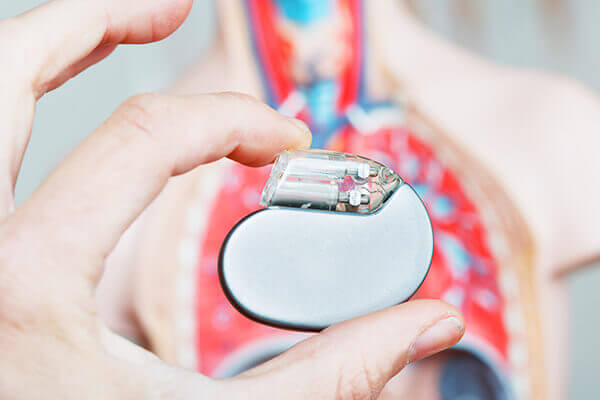Pacemaker
Alpharetta Pacemaker
Regulating Your Heartbeat
For invasive procedures, you would be under the best of care with our physicians who have served as Directors of the Cardiac Catheterization Laboratories at Northside Hospitals Forsyth and Cherokee where they pioneered coronary angioplasty and stenting. Our specialists perform the following procedures at Northside Hospital Forsyth, Northside Hospital Cherokee, Emory Johns Creek Hospital, and St. Joseph’s Hospital of Atlanta.

What is a pacemaker?
A pacemaker is a small, battery-operated device that is inserted under the skin to help regulate your heartbeat. It stimulates the heart by sending it electrical impulses through small wires that run directly to the heart. It is about the size of a two silver dollar coins stacked against each other.
How does it work?
In order to pump your blood, your heart has its own natural pacemaker built-in. This natural pacemaker sends an electrical impulse from the top chamber or right atrium and tells the heart to beat. Because of various health issues, the electrical pathway can become blocked, keeping the signal from being sent through properly. When this happens, your heart rate can become too slow, too fast or irregular. A pacemaker implanted by your cardiologist mimics your heart’s natural pacemaker, monitoring your heart’s pacemaker and sending an electrical impulse to your heart when the natural pacemaker cannot generate a regular heartbeat.
What types of pacemakers are there?
Depending upon your need your doctor will choose which type of pacemaker is best for you. Some pacemakers are used temporarily after a heart attack, surgery, or a medication overdose.
- Signal chamber pacemaker. This pacemaker has one wire that carries a signal from the pulse generator to the right ventricle of the heart.
- Dual chamber pacemaker. With a dual chamber pacemaker, the pacemaker has 2 wires, one to the right atrium and another to the right ventricle. The pacemaker is able to monitor and regulate the timing between the two chambers.
- Biventricular pacemaker. This pacemaker is generally used on people suffering from heart failure and weak heart muscle. It stimulates both the left and right ventricles of the heart.
How is a pacemaker implanted?
When a patient and their cardiologist decide to place a pacemaker they will determine location of placement. Most commonly this is placed just under the skin on the upper chest. These procedures are done at a hospital in the Cardiac Catheterization Laboratory (Cath Lab). After the patient arrives at the Cardiac Cath Lab they are changed into a hospital gown and then placed on the procedure table. They are given light or moderate sedation with usually intravenous Fentanyl and Versed but are not under full anesthesia typically. The area that is going to be worked on is then cleaned and shaved to minimize infection. The cardiologist makes a small incision about 1-2 inches long and slides the pacemaker under the skin. A video screen allows the doctor to position the pacemaker and its wires in the heart. The procedure usually takes about 60 minutes. The physician then sews or staples the small incision and then patient is taken to recovery area.
Are there any restrictions?
After the pacemaker is implanted, you will need to avoid heavy lifting and contact sports for about 30 days while you allow the wires to fully attach. Avoid tight clothing that may rub and irritate the skin around the pacemaker as well. You will need to carry your Pacemaker Card with you always so that any medical personnel know you have an implanted device.
How is it monitored?
Pacemakers need to be checked between every 3-6 months at your cardiologist’s office. This done by using a computer device similar to a TV remote control that non-invasively interrogates or communicates with the device. The purpose of this is to ensure it is functioning properly and to determine how long the battery on the pacemaker will last. The battery life of a new pacemaker is more than 5 years. Once the battery life of the pacemaker is low is can be changed using a small procedure.
